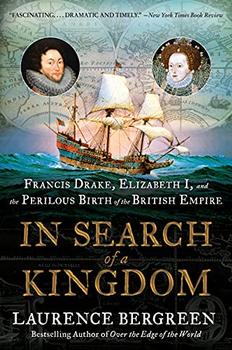Summary | Excerpt | Reviews | Beyond the Book | Readalikes | Genres & Themes | Author Bio
Francis Drake, Elizabeth I, and the Perilous Birth of the British Empire

Critics' Opinion:
Readers' Opinion:
First Published:
Mar 2021, 464 pages
Paperback:
Mar 2022, 464 pages
 Book Reviewed by:
Book Reviewed by:
Rose Rankin
Buy This Book
Drake was daring and resolute. He was short of stature, at most five foot nine, probably closer to five foot seven, and stocky. He had a typically Cornish fondness for painting and drawing. He sketched throughout his travels, the better to comprehend the Lord's creation. Where others saw the world in muted tones, Drake saw the full spectrum. Some pirates loved women, others bloodshed and swordplay. Drake lusted for gold, and when he had stolen enough for several lifetimes, he kept on stealing it, because it was deeply ingrained in his nature to plunder. He was something of a scavenger. Everything belonged to him—potentially—at least all that glittered. He thrust himself into the world, wanting to see it all in the span of years allotted to him. He understood how short life could be, as did everyone in Elizabethan England. Plague, war, and infection frequently menaced the population, to say nothing of the hazards of sailing into the unknown. Nevertheless, the populace steadily increased: two million, three million, eventually four million over the course of Elizabeth's long reign. Her subjects jostled for resources and for space, and so did Drake. The difference was that he had access to ships and, just as important, royal license to create mayhem in the name of the queen, and he happily rose to the occasion. With Drake, fame, fortune, and empire seemed possible, and his bravado made attaining these prizes look inevitable.
The syndicate funding Drake's 1577 expedition included prominent Elizabethans: Robert Dudley; Christopher Hatton, the Earl of Lincoln (the Lord High Admiral); and John Hawkins. Drake contributed £1,000 from the proceeds of his previous raids on Spanish ships and outposts. Elizabeth contributed £1,000, so Drake later claimed, although no record of the transaction exists, which she would have been keen to conceal. William Winter, the surveyor of the queen's ships, added £750. His brother George, clerk of the queen's ships, another £500. (The sole copy of the document listing the other backers was partly destroyed by fire, obscuring their names.) Although she had not given the expedition her official blessing, the queen's apparent participation in Drake's syndicate signaled that it enjoyed her consent, which was almost as good. In this way, Drake's desire for revenge against the Spanish and Queen Elizabeth's budding need for an empire aligned.
The English fleet was led by Drake's 121-foot-long flagship, Pelican, a galleon or multidecked ship commissioned two years earlier and built to his specifications at the Plymouth shipyards. Her beam was estimated at nineteen feet, keel between forty-seven and fifty-nine feet, and length of anywhere from sixty-eight to eighty-one feet (reports vary), with a hold of about nine feet. She was sizable, but hardly overwhelming, probably the largest ship that Drake could afford to build with his loot as a pirate. She was originally called Francis as an indulgence, but Elizabeth preferred to name the ship Pelican, after one of her personal symbols. In the allegorical medieval bestiary, a Pelican symbolized Christ, wounded by humanity's sins. The Pelican> flew with its breast open over the sea and wings outstretched, seeming to mimic Christ's death on the cross. If Pelican hinted at Elizabeth's involvement, the name of the "vice admiral," Elizabeth, revealed the expedition's pedigree. Elizabeth, though smaller, was a more impressive craft than Pelican: eighty tons, fashioned from wood taken from the queen's personal stock, with eleven cast-iron cannon.
The rest of the fleet included a barque, Marigold; a flyboat, Swan; and two pinnaces, Benedict and Christopher, the last of which Drake owned. (A pinnace signified a light boat such as a tender, and also happened to be Elizabethan slang for "harlot.") The crew came to 164, including soldiers, sailors, and apprentices, as well as a dozen "gentlemen."
Excerpted from In Search of a Kingdom by Laurence Bergreen. Copyright © 2021 by Laurence Bergreen. Excerpted by permission of Custom House. All rights reserved. No part of this excerpt may be reproduced or reprinted without permission in writing from the publisher.




Censorship, like charity, should begin at home: but unlike charity, it should end there.
Click Here to find out who said this, as well as discovering other famous literary quotes!
Your guide toexceptional books
BookBrowse seeks out and recommends the best in contemporary fiction and nonfiction—books that not only engage and entertain but also deepen our understanding of ourselves and the world around us.